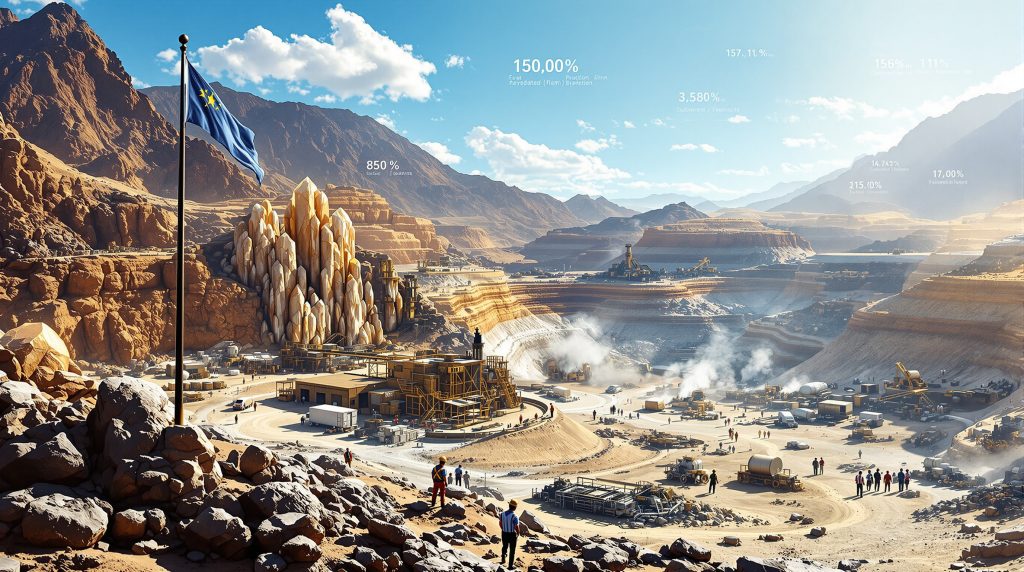Nevada's mining jurisdiction has positioned itself as a cornerstone of America's strategy to secure domestic sources of critical minerals & energy security, with tungsten emerging as a priority target for national security and industrial independence. The Spartan Metals Nevada tungsten revival represents a significant opportunity within this broader strategic initiative. The Silver State's combination of established mining infrastructure, favourable regulatory environment, and historic tungsten production creates a compelling foundation for companies seeking to revive domestic supply chains.
Nevada's Strategic Position in America's Critical Mineral Independence Drive
Why Tungsten Matters for National Security
The United States faces significant strategic vulnerability in tungsten supply, with domestic production virtually nonexistent over the past decade despite the metal's essential role in defence applications. Current import dependency reaches approximately 36% of total consumption, according to U.S. Geological Survey data, with China controlling roughly 83% of global mine production.
Tungsten's exceptional properties make it irreplaceable across multiple strategic sectors:
• Defence applications: Armour-piercing ammunition, aircraft engines, and military electronics
• Industrial manufacturing: Cemented carbides representing 60% of consumption
• Aerospace sector: High-temperature alloys and specialised components
• Technology industries: Electronic contacts and radiation shielding
The strategic importance extends beyond military uses, with tungsten's 3,422°C melting point making it critical for cutting tools, drilling equipment, and wear-resistant applications that underpin manufacturing competitiveness. Furthermore, price volatility has historically ranged from $200-400+ per metric ton unit, creating economic incentives for domestic production development.
Nevada's Historic Tungsten Legacy
Nevada's tungsten production heritage traces back to World War II, when strategic mineral demands drove intensive development across the state's tungsten districts. The Silver Dyke, Tungsten, and Nightingale districts contributed significantly to wartime production, establishing Nevada as a proven tungsten-producing jurisdiction with existing geological knowledge and infrastructure advantages.
Geographic positioning within the Basin and Range province provides Nevada with distinctive geological settings favourable for tungsten mineralisation, particularly contact metamorphic deposits formed by igneous intrusions into carbonate host rocks. This geological framework has generated multiple tungsten districts across the state, creating exploration synergies and shared technical knowledge.
In addition, Nevada's mining-friendly regulatory environment offers additional advantages through established permitting processes, experienced regulatory staff familiar with tungsten projects, and existing infrastructure including power, transportation, and skilled labour. The state's mineral tenure system provides security for long-term development investments, while tax structures remain competitive with other western mining jurisdictions.
How Does Spartan Metals' Eagle Project Stack Against Historic Nevada Producers?
Tungstonia Deposit: Past Performance Indicators
The Tungstonia deposit represents one of Nevada's most significant historic tungsten producers, with operations spanning nearly four decades from 1917 to 1956. Production records indicate consistent grades between 0.6-1.0% WO₃, comparing favourably to global tungsten deposit averages that typically range from 0.1-1.5% tungsten trioxide.
Historic mining limitations reveal substantial expansion potential that modern exploration techniques can address. Previous operations reached maximum depths of only 75 metres, constrained by equipment limitations and economic conditions of the era rather than geological boundaries. Recovery efficiency from 1940s-1950s technology achieved significantly lower extraction rates than modern processing methods, suggesting both the original ore and historic tailings contain substantial value.
The polymetallic nature of the Eagle district adds economic diversification through copper, silver, and rubidium byproducts. Historic production from the Antelope mine achieved grades of 4% copper and 1,000 grams per tonne silver, demonstrating the district's potential for multiple revenue streams that can enhance project economics and reduce commodity price risk.
Geological Advantages of the Eagle District
Contact metamorphism and skarn formation processes have created extensive mineralisation zones around igneous intrusions into carbonate host rocks. This geological setting typically generates large-scale mineralised systems with multiple ore types, explaining the presence of both tungsten-bearing veins and copper-silver carbonate replacement deposits within the same district.
Recent geological work has extended the known vein system continuity from approximately 700 metres of historic mining to nearly 2 kilometres along strike. This lateral extension suggests substantial vertical continuity that historic operations never tested, providing modern exploration with clear expansion targets using systematic drilling programmes.
However, structural controls on mineralisation represent a significant knowledge gap from the historic era that modern exploration can address through integrated geological mapping, geophysical surveys, and 3d geological modeling. Understanding these structural relationships has become fundamental to successful vein and carbonate replacement deposit exploration, offering Spartan competitive advantages over historic operators.
| Historic Nevada Tungsten Comparison | Production Period | Key Characteristics | Modern Potential |
|---|---|---|---|
| Tungstonia (Eagle Project) | 1917-1956 | 0.6-1.0% WO₃, 75m depth | 2km strike, depth extension |
| Silver Dyke District | 1940s-1950s | Multiple small producers | Consolidated development opportunity |
| Tungsten District | WWII era | Skarn-hosted mineralisation | Modern geophysical targeting |
What Sets Spartan's Exploration Strategy Apart from Competitors?
Modern Technology Applied to Historic Data
Spartan's approach centres on validating century-old information through systematic modern exploration techniques that were unavailable to historic operators. Three-dimensional geological modelling capabilities enable visualisation of mineralisation, structure, and lithology relationships before committing capital to drilling programmes.
CSAMT and magnetotelluric geophysical surveys provide subsurface imaging to depths far beyond historic mining levels, allowing identification of structural controls and mineralisation continuity that guided successful tungsten exploration globally. Integration with historic U.S. Bureau of Mines data creates comprehensive targeting frameworks that combine proven mineralisation with modern exploration concepts.
Field verification programmes address data reliability concerns through systematic sampling of historic workings, surface exposures, and tailings materials. This validation approach reduces exploration risk by confirming historic information before incorporating it into resource modelling and drilling programmes.
Phased Development Approach
The $2.25 million Phase 1 programme provides systematic exploration progression from surface work through maiden drilling, avoiding premature capital commitments while building comprehensive geological understanding. Surface exploration includes geological mapping, soil geochemistry, rock chip sampling, and geophysical surveys scheduled for completion through winter 2025-2026.
Maiden drilling targeting spring 2026 will test both historic production areas for validation and step-out positions for expansion potential. The phased approach allows incorporation of all surface data into three-dimensional models that guide optimal drill hole positioning and maximise information return per drilling dollar.
Tailings monetisation provides interim revenue potential while advancing primary resource development. The 10,000-tonne tailings pile grading 0.15% WO₃ offers rapid pathway to cash generation through toll treatment partnerships, reducing dependence on equity financing during exploration phases.
Leadership Experience Factor
CEO Brett Marsh brings 25 years of professional geology experience spanning major mining companies, junior explorers, and global consulting roles. His background includes diverse commodity experience and project development expertise across multiple jurisdictions, providing technical credibility for executing complex multi-target exploration programmes.
Team expansion has added specialised geological expertise, including senior geologist Rebecca Ball, whom Marsh describes as exceptional based on previous collaboration. The strategy balances permanent staff with specialised consultants who provide specific technical capabilities as project requirements evolve.
Strategic acquisition from Ridgeline Minerals provided advanced project development with compiled historic data, reducing early-stage costs and accelerating timelines to meaningful exploration milestones. The acquisition structure maintains ongoing relationships with the selling entity, preserving continuity in project knowledge and technical understanding.
Can the 10,000-Tonne Tailings Pile Generate Near-Term Revenue?
Tailings Reprocessing Economics
The historic tailings pile represents immediate drilling targets with estimated grades of 0.15% WO₃ across approximately 10,000 tonnes of material. Drilling commenced October 20, 2025, with objectives including volume verification, grade distribution mapping, and metallurgical testing to determine optimal recovery methods.
Toll treatment partnerships offer the most practical monetisation approach for this tonnage scale, avoiding capital requirements for standalone processing infrastructure while accessing established downstream technology and capabilities. This strategy enables rapid revenue generation compared to greenfield mine development timelines.
Metallurgical testing will establish baseline recovery data applicable to future mining operations at Tungstonia. Historic recovery efficiency from 1940s-1950s technology achieved significantly lower extraction rates than modern processing methods, suggesting both tailings and future ore could yield substantially improved metallurgical performance.
Environmental and Regulatory Advantages
Existing disturbance areas reduce permitting complexity compared to greenfield development, as tailings reprocessing occurs within previously disturbed zones with established access infrastructure. Environmental baseline conditions are simplified due to historic mining activities and existing regulatory frameworks.
Potential soil remediation benefits arise from investigating tungsten leaching from tailings into underlying native soils over the past century. This investigation could expand the potential resource while addressing environmental remediation requirements, creating dual value through resource expansion and environmental improvement.
Timeline Advantage: Tailings vs. Primary Mining
Tailings reprocessing typically requires 12-18 months from drilling to production, compared to 3-5 years for primary mine development. This positions Spartan for potential cash generation while advancing the main Tungstonia resource development.
How Does Government Support Impact Spartan's Development Timeline?
Federal Critical Minerals Initiatives
Tungsten's inclusion in the U.S. critical minerals list creates eligibility for multiple federal support programmes designed to enhance domestic supply chain security. Defence Production Act applications provide potential funding for tungsten projects that demonstrate strategic value to national security objectives.
Department of Energy loan programmes offer financing for critical minerals projects under expanded authorities from the Energy Act of 2020 and Infrastructure Investment and Jobs Act. These programmes provide below-market financing for qualified projects that enhance domestic critical mineral supply capabilities.
Furthermore, the us mineral production order and tax incentive structures include the Advanced Manufacturing Production Credit (45X) from the Inflation Reduction Act, which covers critical minerals processing and provides production-based tax credits for domestic operations. Strategic partnerships with government entities could create offtake arrangements that provide revenue security and project financing advantages.
Competitive Landscape Analysis
The domestic tungsten exploration sector includes several advancing projects that benefit from similar government support initiatives. Understanding competitive positioning helps evaluate Spartan's relative advantages and potential strategic partnerships within the broader domestic tungsten development landscape.
Market positioning relative to funded competitors requires ongoing monitoring of permitting progress, resource development, and strategic partnerships across the sector. Spartan's advantages include Nevada's mining-friendly jurisdiction, historic production validation, and near-term tailings monetisation potential that differentiates it from purely grassroots exploration projects.
Federal interest in multiple domestic tungsten projects suggests sector-wide support rather than winner-take-all competition, with potential for strategic cooperation and shared infrastructure development that benefits all advancing projects.
What Are the Technical Risks and Mitigation Strategies?
Historic Data Validation Challenges
Century-old mining information presents reliability concerns that require systematic field verification before incorporation into modern resource modelling. While U.S. Bureau of Mines data from the 1940s followed systematic protocols, technological limitations and different analytical methods necessitate validation through contemporary sampling and analysis.
Structural geology knowledge gaps from the historic era require comprehensive mapping and geophysical surveys to understand controls on mineralisation. Modern exploration techniques can address these limitations through integrated data collection programmes that build three-dimensional geological models incorporating both historic information and contemporary data.
Field verification requirements include surface sampling of historic workings, systematic mapping of geological relationships, and strategic drilling in areas of known historic production to confirm grades and continuity before expanding exploration programmes.
Metallurgical and Processing Considerations
Scheelite recovery optimisation requires modern flotation and gravity separation techniques that achieve significantly better performance than historic operations. Metallurgical testing programmes must establish optimal processing methods for both tailings reprocessing and future mining operations.
Byproduct credit potential from copper, silver, and rubidium could enhance project economics through additional revenue streams, but requires comprehensive metallurgical testing to determine recovery methods and concentrate specifications. Processing technology partnerships provide access to specialised expertise without capital requirements for standalone infrastructure development.
Infrastructure requirements for commercial production include power supply, water availability, transportation access, and skilled labour availability. Nevada's established mining infrastructure provides advantages in these areas compared to remote jurisdictions without existing mining support services.
Why Now? Market Timing for Tungsten Revival
Supply Chain Realignment Drivers
Geopolitical tensions affecting Chinese supply dominance have created strategic imperatives for domestic tungsten production that extend beyond cyclical commodity price movements. Supply chain security considerations now influence purchasing decisions across defence, aerospace, and industrial sectors seeking reliable domestic sourcing.
Industrial demand growth in aerospace and defence sectors provides expanding markets for domestic tungsten production, with buyers potentially willing to pay premiums for supply chain security and ESG considerations. Long-term contract potential with strategic buyers offers revenue security that supports project financing and development.
Price volatility creates domestic production incentives as buyers seek alternatives to import dependency and exposure to international supply disruptions. Premium valuations for domestic critical mineral developers reflect investor recognition of strategic value beyond commodity exposure.
Investment Climate for Critical Minerals
ESG considerations increasingly favour domestic sourcing over international supply chains with uncertain environmental and social practices. Institutional investors and strategic buyers prioritise supply chain transparency and domestic production capabilities in investment decisions.
Strategic investor interest in supply chain security creates potential partnerships beyond traditional mining finance, including end-users seeking vertical integration and government entities supporting strategic objectives. Government co-investment opportunities provide non-dilutive funding sources that enhance project economics.
Premium valuations for domestic critical mineral developers reflect strategic value recognition that transcends traditional mining sector metrics, creating investment opportunities for projects that successfully navigate development challenges.
Key Investment Metrics Summary
• Historic production: Tungstonia grades of 0.6-1.0% WO₃ with proven mineralisation
• Exploration target: 2-kilometre strike length with depth potential beyond 75m historic limit
• Near-term catalyst: 10,000-tonne tailings drilling at 0.15% WO₃ commenced October 2025
• Funding status: $2.25 million Phase 1 programme fully funded through maiden drilling
• Timeline: Surface work through 2025, maiden drilling spring 2026 target
Investment Thesis: Weighing Opportunity Against Execution Risk
Competitive Advantages Summary
Historic production validation reduces exploration risk through confirmed ore quality and established mineralisation continuity over substantial strike length. The Tungstonia deposit's 0.6-1.0% WO₃ grades compare favourably to global tungsten deposits and demonstrate economic mineralisation under historic technology and pricing conditions.
Near-term revenue potential through tailings reprocessing provides cash generation capability while advancing primary resource development. The 10,000-tonne tailings pile offers rapid pathway to production compared to greenfield development timelines, with drilling results expected to establish monetisation potential through toll treatment partnerships.
Strategic timing with government critical minerals focus creates multiple value creation pathways beyond commodity price exposure. Federal support programmes, tax incentives, and strategic partnerships provide non-dilutive financing opportunities and revenue security through offtake arrangements with government entities and strategic buyers.
Polymetallic optionality provides portfolio diversification within a single district, allowing management to optimise development sequence based on market conditions. Copper-silver potential at the Antelope mine and rubidium byproduct opportunities create multiple revenue streams that enhance project economics and reduce commodity price risk.
Key Risk Factors to Monitor
Historic data validation outcomes from field verification programmes will determine the reliability of century-old information for modern resource modelling. While systematic protocols guided historic data collection, technological limitations require contemporary validation before incorporating this information into development planning.
Metallurgical recovery rates compared to historic operations represent crucial uncertainties that drilling and testing programmes must address. Modern processing techniques should achieve better performance than 1940s-1950s methods, but specific recovery rates and concentrate specifications require experimental verification.
Permitting timelines for both tailings reprocessing and primary mining operations could affect development schedules and cash flow projections. Nevada's established regulatory framework provides advantages, but environmental baseline requirements and community engagement processes require careful management.
Tungsten price volatility affects project economics despite strategic value premiums, with pricing influenced by Chinese production decisions, international trade policies, and industrial demand fluctuations. Long-term contract potential with strategic buyers could mitigate price risk but requires successful project advancement to commercial negotiations.
What Makes This Different from Typical Junior Mining Speculation?
Tangible Assets and Proven Mineralisation
Physical tailings pile providing immediate drilling targets represents tangible asset value distinct from grassroots exploration projects. The 10,000-tonne volume at 0.15% WO₃ offers rapid data generation and potential monetisation through established processing technologies and toll treatment partnerships.
Historic production records confirming ore quality eliminate fundamental geological risk through documented mineralisation over substantial strike length and multiple decades of operation. The combination of 0.6-1.0% WO₃ grades at Tungstonia and 4% copper, 1,000 g/t silver at Antelope demonstrates district-scale mineralisation potential.
Existing infrastructure reduces development capital requirements through established access roads, power proximity, and previous disturbance areas that simplify permitting processes. Nevada's mining jurisdiction provides regulatory predictability and established support services that reduce development risks and timeline uncertainties.
Clear pathway from exploration to production distinguishes Spartan from speculative projects lacking defined advancement strategies. The systematic approach from tailings monetisation through surface exploration to maiden drilling provides measurable milestones and de-risking progression toward commercial development.
Strategic Value Beyond Commodity Exposure
National security implications create value recognition that extends beyond traditional mining sector metrics, with government interest in domestic tungsten production providing strategic partnerships and funding opportunities unavailable to conventional mineral exploration companies.
Supply chain integration opportunities with defence contractors and industrial end-users offer revenue security through long-term contracts and strategic partnerships that provide financing advantages and market access. Premium pricing potential for domestic tungsten production reflects buyer willingness to pay security-of-supply premiums.
Government partnership potential enhances project viability through federal support programmes, tax incentives, and potential offtake arrangements that improve project economics and reduce financing requirements. Strategic value recognition creates investment opportunities beyond commodity price exposure.
Technical Fundamentals and Development Pathway
Geological Framework and Expansion Potential
The contact metamorphic geological setting at Eagle represents a classic environment for tungsten mineralisation, with igneous intrusions into carbonate host rocks creating extensive skarn zones and vein systems. This geological framework typically generates large-scale mineralised systems with multiple ore types, explaining the district's polymetallic character.
Vein system continuity from 700 metres of historic mining to approximately 2 kilometres along strike demonstrates significant lateral extent that suggests substantial vertical continuity. Historic mining reaching only 75 metres depth provides clear expansion targets for modern exploration using systematic drilling and geophysical techniques.
Structural controls on mineralisation represent the most significant knowledge gap from historic operations, with modern exploration techniques capable of addressing these limitations through integrated geological mapping, geophysical surveys, and three-dimensional modelling programmes.
Modern Exploration Technology Application
CSAMT and magnetotelluric geophysical surveys provide subsurface imaging capabilities to depths far beyond historic exploration limits, enabling identification of structural controls and mineralisation continuity that guide successful tungsten exploration programmes globally.
Three-dimensional geological modelling integrates historic data with contemporary exploration results, enabling visualisation of mineralisation, structure, and lithology relationships before committing capital to drilling programmes. This technology provides targeting capabilities unavailable to historic operators.
Systematic validation approach addresses historic data reliability through field verification programmes that confirm mineralisation and geological relationships before incorporation into resource modelling and drilling programmes.
Processing and Metallurgical Considerations
Scheelite recovery requires specialised processing techniques including gravity separation and flotation methods that have improved significantly since 1940s-1950s operations. Modern processing typically achieves 85-95% recovery rates compared to substantially lower historic efficiency levels.
Byproduct recovery potential from copper, silver, rubidium, and manganese could enhance project economics through additional revenue streams, though metallurgical testing must establish optimal recovery methods and concentrate specifications for each commodity.
Toll treatment partnerships provide access to specialised processing technology without capital requirements for standalone infrastructure, enabling rapid monetisation of both tailings material and future ore production through established downstream capabilities.
Frequently Asked Questions
Timeline and Development Questions
When will drilling results be available from the tailings programme?
Drilling commenced October 20, 2025, with results expected through winter 2025-2026. Metallurgical testing and resource modelling will extend into spring 2026, providing comprehensive evaluation of tailings monetisation potential alongside maiden drilling programmes on primary targets.
What triggers the decision to proceed with primary resource drilling?
Surface exploration results including geological mapping, soil geochemistry, rock sampling, and geophysical surveys will guide drill targeting decisions. Three-dimensional modelling incorporating all data sources will identify optimal drilling locations for spring 2026 maiden drilling programmes.
How long from discovery to production for the main Tungstonia deposit?
Primary mine development typically requires 3-5 years from resource definition through production, though Nevada's established mining jurisdiction and existing infrastructure could accelerate timelines. Tailings reprocessing offers interim production potential within 12-18 months of positive development decisions.
Financial and Investment Considerations
What additional funding will be required beyond Phase 1?
Resource definition drilling and preliminary economic assessments will determine capital requirements for development phases. Government support programmes, strategic partnerships, and debt financing could reduce equity dilution requirements compared to conventional mining finance structures.
How does Spartan plan to monetise the polymetallic nature of the deposit?
Sequential development based on market conditions allows optimisation of commodity focus, with tungsten providing strategic value premiums while copper-silver potential offers additional revenue streams. Integrated processing or separate concentrate production will depend on metallurgical testing results and market considerations.
What are the key milestones investors should monitor?
Tailings drilling results through winter 2025-2026, surface exploration data integration, maiden drilling results in spring-summer 2026, and government partnership developments represent primary near-term catalysts for value creation and project advancement.
Technical and Operational Queries
How reliable is century-old mining data for modern resource estimation?
U.S. Bureau of Mines data followed systematic protocols for the era, though technological limitations require validation through contemporary sampling and analysis. Field verification programmes will confirm historic information reliability before incorporation into modern resource modelling frameworks.
What processing methods will be used for tungsten recovery?
Modern scheelite recovery employs gravity separation and flotation techniques achieving significantly better performance than historic operations. Toll treatment partnerships provide access to specialised processing technology without capital requirements for standalone infrastructure development.
How does Nevada's regulatory environment compare to other mining jurisdictions?
Nevada offers established mining regulations, experienced regulatory staff, and predictable permitting processes that reduce development risks compared to jurisdictions without extensive mining experience. Environmental baseline requirements and community engagement remain standard considerations for responsible development.
The Spartan Metals Nevada tungsten revival represents a unique convergence of strategic timing, proven mineralisation, and systematic development approach within America's broader mining industry innovation landscape. Furthermore, the project's emphasis on environmental stewardship through mine reclamation innovation demonstrates responsible mining practices essential for modern project development. The combination of historic validation, modern exploration techniques, and government support for critical mineral independence creates compelling investment metrics beyond traditional commodity exposure. For investors seeking exposure to America's strategic mineral independence initiative, Spartan Metals provides a tangible pathway from proven historic production through systematic exploration toward commercial development within Nevada's established mining jurisdiction.
Are You Positioned for the Next Wave of Strategic Mineral Discoveries?
The Nevada tungsten revival showcases exactly why sophisticated investors monitor ASX mineral discoveries powered by Discovery Alert's proprietary Discovery IQ model for immediate market advantages. Discover how major mineral breakthroughs can deliver substantial returns by examining historic examples, then begin your 30-day free trial today to position yourself ahead of strategic developments across critical minerals, base metals, and precious metals sectors.




